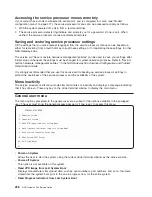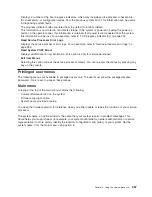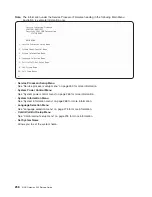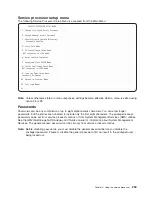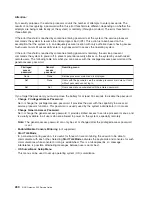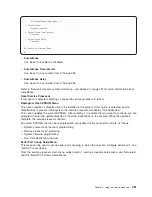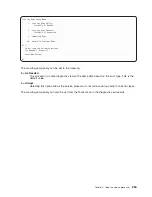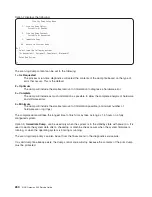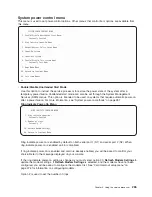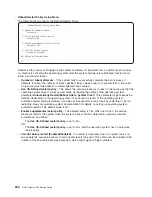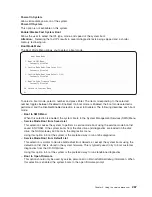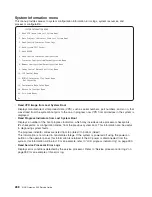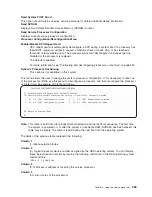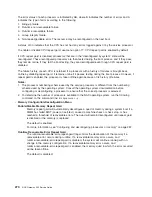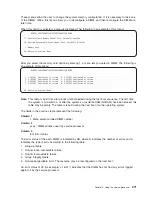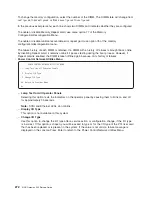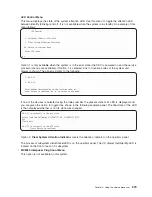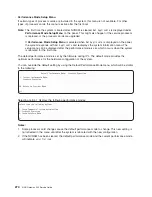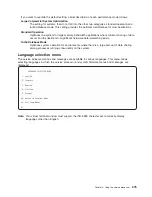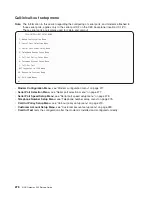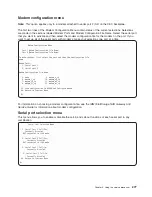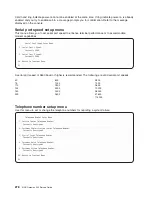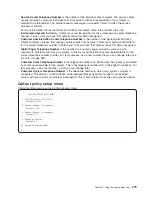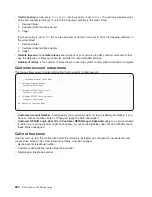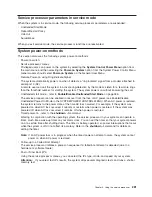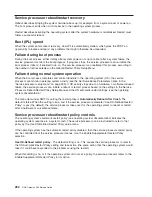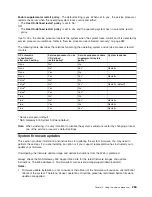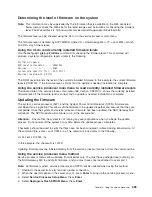
The error status of each processor is indicated by AB, where B indicates the number of errors and A
indicates the type of error according to the following:
1. Bring-up failure
2. Run-time non-recoverable failure
3. Run-time recoverable failure
4. Group integrity failure
5. Non-repeat-gardable error. The resource may be reconfigured on the next boot.
A status of 00 indicates that the CPU has not had any errors logged against it by the service processor.
To enable or disable CPU repeat gard, use menu option 77. CPU repeat gard is enabled by default.
If CPU repeat gard is disabled, processors that are in the
″
deconfigured by system
″
state will be
reconfigured. These reconfigured processors are then tested during the boot process, and if they pass,
they remain online. If they fail the boot testing, they are deconfigured even though CPU repeat gard is
disabled.
The failure history of each CPU is retained. If a processor with a history of failures is brought back
online by disabling repeat gard, it remains online if it passes testing during the boot process. However, if
repeat gard is enabled, the processor is taken offline again because of its history of failures.
Notes:
1. The processor numbering scheme used by the service processor is different from the numbering
scheme used by the operating system. Consult the operating system documentation before
configuring or deconfiguring a processor to ensure that the correct processor is selected.
2. To determine the number of processors available to the NAS operating system, run the following
command on the command line:
bindprocessor -q
v
Memory Configuration/Deconfiguration Menu
Enable/Disable Memory Repeat Gard
Memory repeat gard will automatically deconfigure a quad of memory during a system boot if a
DIMM has failed BIST (power-on self-test), caused a machine check or check stop, or has
reached a threshold of recoverable errors. The quad will remain deconfigured until repeat gard
is disabled or the memory is replaced.
The default is enabled.
For more information, see “Configuring and deconfiguring processors or memory” on page 287.
Runtime Recoverable Error Repeat Gard
The runtime-recoverable-error-repeat-gard flag controls the deallocation of the memory if a
recoverable error occurs during runtime. If a recoverable-memory error occurs, and
runtime-recoverable-error-repeat gard is disabled, the system will continue running with no
change in the memory configuration. If a recoverable-memory error occurs, and
runtime-recoverable-error-repeat gard is enabled, the memory quad in which the error occurred
will be taken offline.
The default is disabled.
270
NAS Gateway 500 Service Guide
Summary of Contents for TotalStorage NAS Gateway 500
Page 1: ...IBM TotalStorage NAS Gateway 500 Service Guide GY27 0418 00 ...
Page 2: ......
Page 3: ...IBM TotalStorage NAS Gateway 500 Service Guide GY27 0418 00 ...
Page 16: ...xiv NAS Gateway 500 Service Guide ...
Page 20: ...xviii NAS Gateway 500 Service Guide ...
Page 36: ...System logic flow Note Not all components are supported 16 NAS Gateway 500 Service Guide ...
Page 52: ...32 NAS Gateway 500 Service Guide ...
Page 58: ...38 NAS Gateway 500 Service Guide ...
Page 112: ...92 NAS Gateway 500 Service Guide ...
Page 266: ...246 NAS Gateway 500 Service Guide ...
Page 326: ...306 NAS Gateway 500 Service Guide ...
Page 353: ...Chapter 11 Removal and replacement procedures 333 ...
Page 392: ...372 NAS Gateway 500 Service Guide ...
Page 402: ...382 NAS Gateway 500 Service Guide ...
Page 412: ...392 NAS Gateway 500 Service Guide ...
Page 440: ...420 NAS Gateway 500 Service Guide ...
Page 446: ...426 NAS Gateway 500 Service Guide ...
Page 448: ...428 NAS Gateway 500 Service Guide ...
Page 466: ...446 NAS Gateway 500 Service Guide ...
Page 469: ......
Page 470: ... Printed in U S A GY27 0418 00 ...
Page 471: ...Spine information IBM TotalStorage NAS Gateway 500 NAS Gateway 500 Service Guide GY27 0418 00 ...

